If it’s time to replace your old furnace, consider getting an energy-efficient one that will save you money and help the environment. Products that are Energy Star-certified are great options. To make the best choice, consider models with the following features.
Heat Pumps
A heat pump can efficiently warm your home by moving the air around instead of converting it from fuel. It is the most cost-effective choice for smaller homes and can double as an air conditioner.
Here are the different types to choose from:
- Ducted vs. ductless: Ductless models move heat from an outdoor unit to smaller air handlers indoors without metal ducts. Ducted models require more complex installations.
- Split vs. packaged: Split systems have an individual coil inside and outside, and the supply and return ducts attach to an indoor fan. Packaged units have both the coil and fan located outside.
- Multi-zone vs. single-zone: Single zone has one outdoor condenser matched with an indoor condenser. Multi-zone, on the other hand, has two or more outdoor condensers associated with the indoor one.
Electric Furnace
This type of furnace is more environmentally friendly than oil or gas models. They use electrical heating systems to raise the temperature instead of burning fuel. During this process, the air goes through a heat exchanger, and the metal wires inside are warmed up by electrically charged particles.
You want to look for a furnace with a high average fuel utilization efficiency (AFUE) rating. This refers to the ratio of annual heat output to the yearly energy it consumes. This number should be 80% or higher, according to the U.S. Department of Energy. There should be a bright yellow label on your furnace to verify it is AFUE-certified.
Another perk of electric heating systems is versatility. You can use them for cooking and powering your lights all at the same time.
Condensed Heating
When looking for an eco-friendly heater, consider purchasing a condensed heating furnace. These maximize energy use through a direct connection between the supply lines and the combustion chambers.
In addition, condensed systems are safer. All the parts are sealed from the inside to prevent excess gases from leaking out.
When it comes to installing the furnace, be sure to read the manual carefully. Consider adding chimney liners for proper venting. Also, make sure your furnace is level towards the drain to allow liquid to clear out. It is essential to get the correct size furnace to reduce the risk of oversizing, too. Here are three reasons why:
- To prevent short firing cycles
- To control temperature swings
- To reduce the amount of excess airflow
Additional Tips for Maximizing Your Energy
Now that you know the types of systems to look for, here are some ways additional ways to save energy.
1. Do a Maintenance Check
At least once a year, have a professional come and check on your heating system. This will ensure it is functioning correctly. Also, make sure the contractor cleans and fixes the components that help increase efficiency, like the gas burners and air distribution filters.
2. Update Your Thermostats
Consider getting a smart thermostat to more effectively control the temperature of your house. They lower the temperature when you’re not home and turn it higher once you return to save energy.
Here are some additional items to add to your home to be more environmentally friendly:
- Recycling bins
- Solar panels
- Rain barrels
- Smart power strips
3. Seal the Seams
Make sure you seal up every hole in the system to prevent leaks. Here are the steps to seal up your furnace:
- For smaller gaps, seal with silicone caulk. You want to use a bead and run it over the hole to smooth it. If the crack is near the heat exchanger, use a temperature-resistant silicone caulk.
- For larger gaps, cover with foam sealant by spraying it inside the hole. Once dried, cut and shape it with a utility knife and sandpaper.
- Seal all the holes with aluminum foil duct tape. First, wipe down the area with a damp rag. When it dries, tape over the opening and press firmly. Cut it to the proper length with a utility knife.
Ways to Create a More Energy-Efficient and Eco-Friendly Home
The furnace is a critical appliance in your home. To save energy and protect the environment, consider these tips when making your purchase.


